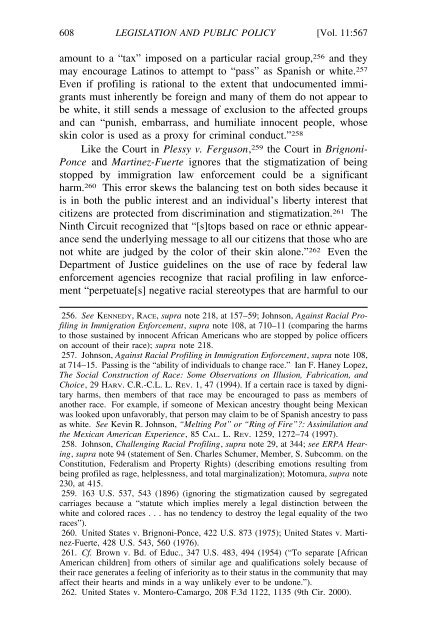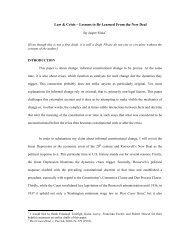updating brignoni-ponce - New York University School of Law
updating brignoni-ponce - New York University School of Law
updating brignoni-ponce - New York University School of Law
You also want an ePaper? Increase the reach of your titles
YUMPU automatically turns print PDFs into web optimized ePapers that Google loves.
608 LEGISLATION AND PUBLIC POLICY [Vol. 11:567<br />
amount to a “tax” imposed on a particular racial group, 256 and they<br />
may encourage Latinos to attempt to “pass” as Spanish or white. 257<br />
Even if pr<strong>of</strong>iling is rational to the extent that undocumented immigrants<br />
must inherently be foreign and many <strong>of</strong> them do not appear to<br />
be white, it still sends a message <strong>of</strong> exclusion to the affected groups<br />
and can “punish, embarrass, and humiliate innocent people, whose<br />
skin color is used as a proxy for criminal conduct.” 258<br />
Like the Court in Plessy v. Ferguson, 259 the Court in Brignoni-<br />
Ponce and Martinez-Fuerte ignores that the stigmatization <strong>of</strong> being<br />
stopped by immigration law enforcement could be a significant<br />
harm. 260 This error skews the balancing test on both sides because it<br />
is in both the public interest and an individual’s liberty interest that<br />
citizens are protected from discrimination and stigmatization. 261 The<br />
Ninth Circuit recognized that “[s]tops based on race or ethnic appearance<br />
send the underlying message to all our citizens that those who are<br />
not white are judged by the color <strong>of</strong> their skin alone.” 262 Even the<br />
Department <strong>of</strong> Justice guidelines on the use <strong>of</strong> race by federal law<br />
enforcement agencies recognize that racial pr<strong>of</strong>iling in law enforcement<br />
“perpetuate[s] negative racial stereotypes that are harmful to our<br />
256. See KENNEDY, RACE, supra note 218, at 157–59; Johnson, Against Racial Pro- R<br />
filing in Immigration Enforcement, supra note 108, at 710–11 (comparing the harms R<br />
to those sustained by innocent African Americans who are stopped by police <strong>of</strong>ficers<br />
on account <strong>of</strong> their race); supra note 218. R<br />
257. Johnson, Against Racial Pr<strong>of</strong>iling in Immigration Enforcement, supra note 108, R<br />
at 714–15. Passing is the “ability <strong>of</strong> individuals to change race.” Ian F. Haney Lopez,<br />
The Social Construction <strong>of</strong> Race: Some Observations on Illusion, Fabrication, and<br />
Choice, 29 HARV. C.R.-C.L. L. REV. 1, 47 (1994). If a certain race is taxed by dignitary<br />
harms, then members <strong>of</strong> that race may be encouraged to pass as members <strong>of</strong><br />
another race. For example, if someone <strong>of</strong> Mexican ancestry thought being Mexican<br />
was looked upon unfavorably, that person may claim to be <strong>of</strong> Spanish ancestry to pass<br />
as white. See Kevin R. Johnson, “Melting Pot” or “Ring <strong>of</strong> Fire”?: Assimilation and<br />
the Mexican American Experience, 85 CAL. L. REV. 1259, 1272–74 (1997).<br />
258. Johnson, Challenging Racial Pr<strong>of</strong>iling, supra note 29, at 344; see ERPA Hear- R<br />
ing, supra note 94 (statement <strong>of</strong> Sen. Charles Schumer, Member, S. Subcomm. on the R<br />
Constitution, Federalism and Property Rights) (describing emotions resulting from<br />
being pr<strong>of</strong>iled as rage, helplessness, and total marginalization); Motomura, supra note<br />
230, at 415. R<br />
259. 163 U.S. 537, 543 (1896) (ignoring the stigmatization caused by segregated<br />
carriages because a “statute which implies merely a legal distinction between the<br />
white and colored races . . . has no tendency to destroy the legal equality <strong>of</strong> the two<br />
races”).<br />
260. United States v. Brignoni-Ponce, 422 U.S. 873 (1975); United States v. Martinez-Fuerte,<br />
428 U.S. 543, 560 (1976).<br />
261. Cf. Brown v. Bd. <strong>of</strong> Educ., 347 U.S. 483, 494 (1954) (“To separate [African<br />
American children] from others <strong>of</strong> similar age and qualifications solely because <strong>of</strong><br />
their race generates a feeling <strong>of</strong> inferiority as to their status in the community that may<br />
affect their hearts and minds in a way unlikely ever to be undone.”).<br />
262. United States v. Montero-Camargo, 208 F.3d 1122, 1135 (9th Cir. 2000).
















